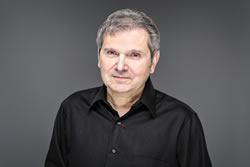TIES 2014
8th Toronto International Electroacoustic Symposium
The eighth edition of the Toronto International Electroacoustic Symposium welcomed Pauline Oliveros as Keynote Speaker. Two dozen composers, performers, researchers and institutions presented recent work and reflections on instrument and technology development, technologies and accessibility, notation, compositional praxis, sound art and more.
Schedules, abstracts and programme notes from the symposium are available on the TIES 2014 pages. A TIES 2014 Photo Album has also been posted to the CEC’s Facebook page.

About This Issue
Editorial
Keynote Address

What Matters? Make the Music!
Returning to Toronto, where her earliest compositions were created, TIES 2014 Keynote Speaker Pauline Oliveros presented an overview of almost 50 years of practice through a selection of her tape compositions, improvisation and deep listening projects, and collaborations with other key artists working since the 1960s.
Articles
Vibrating Instruments and New Technologies

Frank Morse Robb’s Wave Organ: The world’s first electronic organ
Frank Morse Robb invented the world’s first electronic organ in 1927. His Wave Organ used sample-based synthesis to sound like a pipe organ. Thought to have been lost, it has been recreated and can now be heard again.

Resounding but Not Sounding: Diffusing into interior spaces of instruments
The artistic practice of diffusing electroacoustic sound inside of or through acoustic instruments is examined, which leads to a brief discussion of some of the author’s own compositional work using such practice and the conceptual issues emerging from it.

Studies in Sound and Vibration: VibraFusionLab, An innovative centre for arts-based vibrotactile research and creative practice
In an effort to broaden experiential realms of art making and expand and enrich audience involvement, VibraFusionLab explores emerging adaptive technologies as artistic tools and a means of creative expression.

“In Flight” and Audio Spray Gun: Generative composition of large sound-groups
Audio Spray Gun is a computer programme that simultaneously generates and spatializes large groups of sound-events derived from a single sound sample. The author’s acousmatic work In Flight was composed entirely from such groups.
Compositional Praxis via Hybrid Practices

Implications of Electroacoustic Composition in an Intercultural Context: Negotiating cultural meanings and uses of timbre
Timbre, which gives music culture its identity, is examined in the intercultural electroacoustic music context. With the West’s history with other cultures, can technology engage instrument timbre without obscuring cultural identity? The author’s Twelve Landscape Views is discussed in this context.

Spectralism and Microsound
Although both are defined by strong foundations in acoustics and psychoacoustics, spectralism is primarily concerned with the frequency domain while microsound composition focuses on the temporal dimension. The author investigated relationships and interactions between the two paradigms, drawing upon these phenomena in The Damages of Gravity.

Sonification as Semblance: A phenomenological investigation into music composition
Sonification is interrogated from the position of existential phenomenology, seeking to attribute the semblic problematic of sonification to a neglect of spatiotemporality. This discussion is intended to engage the community with philosophical discourse beyond the remit of axiology.

When Worlds Collide: Tackling graphic notation in live electronic music
Aspects of animated notation are discussed with the goal of improving live electronic music performance practice. Following brief case studies of works that use of animated notation, a set of simple guidelines support the application of this relatively new approach to music notation.
Technology and Access

Twiddling and Twerking: Thoughts on electroacoustic music performance
A broad (and slightly wary) view of the state of performative electroacoustic music, considering, in particular, the current roles of performance gestures (“twiddling”) in interactive works, and conspicuous arrays of technology (“twerking”) for primarily acousmatic works.

Hive: An audio programming language informed by the theory of cognitive dimensions
Hive was developed to simplify SuperCollider’s syntax in order to make audio programming clearer for novice users. Designed to be a foundational language for broader coding practices, Hive is a stepping stone to push novice users to explore audio programming even further.

Three Electroacoustic Artworks Exposing Digital Networks
A three-part research-creation project exploring the functional and æsthetic aspects of digital networks that can be exposed and employed by artists: an interactive installation, a laptop orchestra composition and an interactive sculpture.
Sonic Art, a Reflection on and of Identity

Sound Never Ages: Archaeoacoustic memory
Psychoacoustic research tells of how infrasound arising from landscape architecture and a 5300-year-old “medicine wheel” — an alignment of placed stones spread out over 20 square kilometres on the Canadian prairie — affects the human central nervous system.

Una Casa de Sonidos: Sonic storytelling with Central American refugee minors
The Casa de Sonidos project brought unaccompanied, undocumented youth in U.S. Federal custody into contact with a variety of audio production techniques. The resulting sounds were presented as an interactive soundscape inviting visitors to bear witness to the invisible presence of these youth.
Other Items
Photos from TIES 2014
Photos selection from the 2014 symposium.
SONUS.ca
Works by some authors and / or artists in this issue can be heard in SONUS.ca, the CEC’s online electroacoustic jukebox:
Media
- Richard Garrett — In Flight (2014 / 6:31)
- Pauline Oliveros — I of IV (1966 / 4:43)
- Pauline Oliveros — Cannery Row (1990 / 18:05)
- Pauline Oliveros — Suiren (1988 / 10:01)
- Pauline Oliveros — This Great Fool’s Stage (1986 / 5:11)
- Pauline Oliveros — Time Perspectives 1961 (1961 / 5:42)
- Pauline Oliveros, Terry Riley and Loren Rush — Improvisation #1 (1957 / 16:01).
- Jeffrey Roberts — Twelve Landscape Views: III. Guqin, Saxophone, Electronics (2014 / 6:03)
- Candaş Şişman — SYN-Phon (2013 / 9:38) for cello, trumpet and electronics or objects [Video]
- Ryan Ross Smith — Study No. 31 (2013 / 5:48) for 7 triangles and electronics [Video]
- Lindsey Vickery — Nature Forms I (2014 / 9:38) for 3 undefined instruments and electronics [Video]
Social top